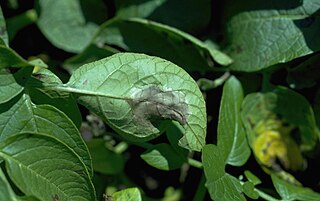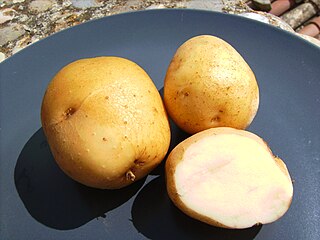Related Research Articles

The potato is a starchy food, a tuber of the plant Solanum tuberosum and is a root vegetable native to the Americas. The plant is a perennial in the nightshade family Solanaceae.

Phytophthora infestans is an oomycete or water mold, a fungus-like microorganism that causes the serious potato and tomato disease known as late blight or potato blight. Early blight, caused by Alternaria solani, is also often called "potato blight". Late blight was a major culprit in the 1840s European, the 1845–1852 Irish, and the 1846 Highland potato famines. The organism can also infect some other members of the Solanaceae. The pathogen is favored by moist, cool environments: sporulation is optimal at 12–18 °C (54–64 °F) in water-saturated or nearly saturated environments, and zoospore production is favored at temperatures below 15 °C (59 °F). Lesion growth rates are typically optimal at a slightly warmer temperature range of 20 to 24 °C.

Mashed potato or mashed potatoes, colloquially known as mash, is a dish made by mashing boiled or steamed potatoes, usually with added milk, butter, salt and pepper. It is generally served as a side dish to meat or vegetables. Roughly mashed potatoes are sometimes called smashed potatoes. Dehydrated instant mashed potatoes and frozen mashed potatoes are available. Mashed potatoes are an ingredient in other dishes, such as dumplings and gnocchi.

Potato bread is a form of bread in which potato flour or potato replaces a portion of the regular wheat flour. It is cooked in a variety of ways, including baking it on a hot griddle or pan, or in an oven. It may be leavened or unleavened, and may have a variety of other ingredients baked into it. The ratio of potato to wheat flour varies significantly from recipe to recipe, with some recipes having a majority of potato, and others having a majority of wheat flour. Some recipes call for mashed potatoes, with others calling for dehydrated potato flakes. It is available as a commercial product in many countries, with similar variations in ingredients, cooking method, and other variables.

Russet Burbank is a potato cultivar with dark brown skin and few eyes that is the most widely grown potato in North America. A russet type, its flesh is white, dry, and mealy, and it is good for baking, mashing, and french fries (chips). It is a common and popular potato.

The Désirée potato is a red-skinned main-crop potato originally bred in the Netherlands in 1962. It has yellow flesh with a distinctive flavour and is a favourite with allotment-holders because of its resistance to drought, and is fairly resistant to disease. It is a versatile, fairly waxy variety which is firm and holds its shape, and is useful for all methods of cooking, from roasting to mashing and salads.
Golden Wonder is a late maincrop russet skinned variety of potato. It is very dry and floury and is ideal for baking, roasting and frying, but needs close attention paid when boiling, as it will disintegrate in the boiling water if left too long.

Kerr's Pink is a potato cultivar in wide production in Ireland and the United Kingdom and many other countries. Although often quoted as an "Irish potato", the cultivar was actually created by J. Henry of Cornhill, Scotland, in 1907.

King Edward is a potato cultivar grown in the UK since 1902, making it one of the oldest cultivars still grown commercially.

Red Norland is a red, early-maturing potato. Smaller tubers are commonly sold as “baby reds” and this variety is often served boiled or in potato salads. The progenitor variety, 'Norland', was released by the North Dakota Agricultural College in 1957. Since the release of 'Norland', other darker red skinned variants were selected, most notably 'Red Norland' and 'Dark Red Norland'. None of these three varieties is under plant variety protection. The darker red strains are now widely grown, and 'Norland' is rarely grown. 'Norland' and its selections are widely adapted, but have relatively low to intermediate yields.
Skerry Champion is a variety of potato with a round-to-oval shape and creamy yellow skin with a beautiful blue/purple "birthmark" colouring. 'Skerry Champions' have only recently become available to growers again after a long period of absence due to a host of viral diseases it was carrying. Taste quality is excellent with a lovely flavour and floury texture. They are quite highly resistant to blight however the tops of diseased haulms should be removed to keep tubers healthy. It has also been known as Buchan Beauty and although introduced into Ireland in 1922, may have existed in the UK before then.
The Ulster Emblem variety of potato originated in Northern Ireland. It was originally bred by Mr J. Clarke of Ballymoney, Co. Antrim. It has a long oval shape with white skin and flesh which has a semiwaxy texture, reasonable flavour with good cooking quality, and a fairly good yield. This variety has a red violet coloured flower and a pink sprout colour. It also has a high resistance to late blight on the tubers as well as the plant foliage.
Alturas is a russet potato variety released in 2002 by the USDA-ARS and the Agricultural Experiment Stations of Idaho, Oregon, and Washington and it is under plant variety protection. It is a processing potato that has cold-sweetening resistance, so it can be processed directly out of storage into French fries and other frozen potato products.
Superior is a white-skinned, white-fleshed, mid-season potato variety. It was released by the University of Wisconsin potato breeding program in 1962, and is not under plant variety protection. It is a progeny of a cross between 'B96-56' and 'M59.44' and was first grown in 1951. 'B96-56' was also a parent of Kennebec. Like the potato variety Atlantic, Superior is widely grown for potato chip manufacturing right off the field and marketable yields are fairly high.
Champion is a potato variety bred by John Nicoll in Scotland and widely grown in Ireland during the latter half of the 19th century. The tuber is round, with white skin and yellow flesh. The texture is described as "floury".

Kennebec is a medium- to late-maturing white potato. It was bred by the USDA and selected by Presque Isle Station, Maine, in 1941. Kennebec is not under plant variety protection. This fast-growing variety has high yields. It maintains good quality in storage and is grown for both fresh market use and for potato chip manufacturing.
The Ranger Russet is a late-maturing potato that is used for baking and processing into fries. It was originally bred by Joseph J. Pavek of the USDA in Aberdeen, Idaho, and released jointly by the USDA and the agricultural stations of Idaho, Washington, Oregon and Colorado in 1991. Ranger Russet is not under plant variety protection. It yields medium to high numbers of tubers with a short dormancy period.
The Irish Lumper is a varietal white potato of historic interest. It has been identified as the variety of potato whose widespread cultivation throughout Ireland, prior to the 1840s, is implicated in the Irish Great Famine in which an estimated 1 million died.
Innovator is potato variety that is oblong in shape with a smooth skin. It is a popular potato variety in Europe and is gaining popularity in North America as a frying and baking potato. The skin of the potato variety is russeted, similar to that of a Russet Burbank potato. Innovator also has shallow eyes with a cream coloured flesh.

James Clark, was an English market gardener and horticulturist in Christchurch, Dorset who specialised in raising new varieties of potato. His most noted success was Magnum Bonum, described by The Times as "the first real disease-resisting potato ever originated and offered to the world".
References
- ↑ Irish Seed Savers Association
- ↑ "Potato Varieties of Historical Interest in Ireland" (PDF). Ireland's Department of Agriculture, Fisheries and Food. Archived from the original (PDF) on 21 June 2013. Retrieved 14 January 2011.
- ↑ Findlay, Archibald (1905). The Potato: Its History and Culture. Printed by A. Westwood & son.
British Queen potato.
- ↑ Deacon, Alison Deacon, Nigel. "BRITISH QUEEN POTATOES - DIVERSITY WEBSITE". www.suttonelms.org.uk. Retrieved 2016-12-01.
